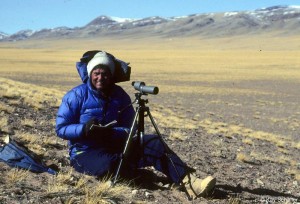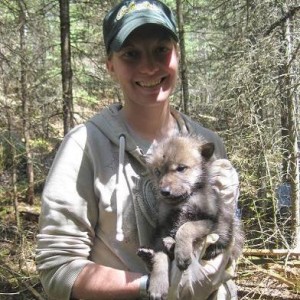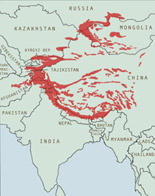A heartfelt congratulations to legendary snow leopard biologist Dr. George Schaller, who has received the National Geographic Society’s Hubbard Medal for his lifetime commitment to conserving the world’s wildlife.
The Hubbard Medal is the Society’s highest honour and recognises achievements in exploration, discovery and research. Past recipients include Jane Goodall and Charles Lindbergh.
Dr Schaller is considered by many to be the world’s preeminent field scientist and naturalist and he has dedicated his life to researching and protecting some of the world’s most endangered species, including snow leopards, mountain gorillas, Tibetan antelope, wild yak, jaguars, giant pandas, lions and tigers.
Snow leopard research
One of his key contributions is the first biologist to study the snow leopard in the wild in the early 1970’s at a time when he says “the snow leopard’s life remains unwritten.” (“Stones of Silence – Journeys into the Himalayas”.)
During 1973, Schaller trekked through the remote Himalayan region of Dolpo to study the Himalayan Bharal, (blue sheep) and locate sign of snow leopards, at that time, a species rarely seen in the wild and rarely studied by field biologists. Bharal are natural prey for snow leopards and in order to understand the diet and feeding habits of the cats their major prey is also studied.
Accompanying him on the Dolpo trip was writer, Zen Buddhist and environmentalist Peter Matthiessen who went on to write the book on their travels titled “The Snow Leopard”, published in 1978. This book brought the reality of the snow leopard to readers throughout the world, many of whom had till that time, believed the snow leopard to be a mythical animal. Matthiessen said of Schaller, “He is one of the finest field biologists of our time.”
During the early 70’s Schaller also spent many months in Chitral area of Pakistan collecting data on snow leopard.

Dr George Schaller’s first ever photo of a snow leopard in the wild. He says “I spotted the snow leopard on a rocky slope high in the Hindu Kush mountains of northern Pakistan on a December day in 1970. She had a kill, a domestic goat, and at the entrance to a rock cleft nearby were her two small cubs.”
Dr Schaller has trekked the mountains of Afghanistan, Tibet, China, Nepal, Tajikistan, Mongolia, Pakistan and India for over 5 decades to study this elusive big cat predator. His photo of a snow leopard taken in Pakistan in 1970 is the first recorded photograph of the wild cat. His work has focused on assessing snow leopard presence, understanding the behaviour and needs of the species as well as its interaction with humans and the threats that humans are to the long term survival of a sustainable population in the wild.
Much of his recent work has been in China’s Qinghai Province where in the Sanjiangyuan Reserve he did the first research on human-snow leopard conflicts on the Tibetan Plateau.
His work in China, along with the Snow Leopard Trust and Shan Shui, one of the leading conservation organizations in China, aims to create a new collaborative snow leopard research and conservation program in China, which has the largest snow leopard population of all range countries, estimated to be 50 percent of the remaining wild population, around 2000 to 3000 individuals.
Conservation efforts
The research work of Dr Schaller has been instrumental in establishing more than 15 protected areas, parks and reserves around the globe on behalf of endangered species. During the 1950’s his work in Alaska resulted in the establishment of the world’s largest wildlife preserve – the Arctic National Wildlife Refuge. In snow leopard range countries he has been a driver for the creation of the Shey-Phoksundo National Park in Nepal, now confirmed to be home to snow leopards. He was also key in the establishment of the Chang Tang Nature Reserve in Tibet, which is over 320,000 square kilometres and was called “One of the most ambitious attempts to arrest the shrinkage of natural ecosystems,” by The New York Times.
Awards and recognition
Dr Schaller has been the recipient of numerous awards. In 2007 the National Geographic conferred its Lifetime Achievement Award upon him and in 2008 he won the prestigious the Indianapolis Prize.
Currently he is the Vice President of Panthera, an organisation founded in 2006 and devoted to the conservation of wild cats and their ecosystems. Congratulations again, Dr Schaller.























